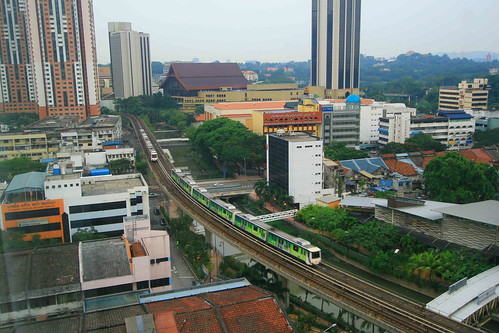Syarikat Prasarana Negara Bhd, is proposing to construct an extension of the Kelana Jaya and Ampang Light Rail Transit (LRT) line. According to the report, the RM7 billion project includes 13 additional stations each for the Kelana Jaya and Ampang line, including an interchange station at Putra Heights. The Kelana Jaya extension comprises of a 17-km track whereas the Ampang Line extension comprises of 17.7-km track. The extension projects are expected to be completed in 2012.
Currently, the documents and proposed plans related to the project are available for public review at Petaling Jaya City Council, Subang Jaya Municipal Council (MPSJ), City Hall headquarters, Shah Alam City Council and Department of Railway at Menara Dayabumi. The documents can be reviewed from Monday to Friday, 9am to 5pm. The public inspection ends on Dec 14.
However, the developers of the extensions projects should consider the following areas of concerned:
The most important aspect is to ensure the choice of train system that can be easily maintained and easily upgraded in the future. For example, due to popular demand, the capacity of each train need to be increased by adding additional coach to the train and make sure that the procured train system allows such an extension. As an alternative, the number of trains need to be increased in the future (to increase train frequency) to meet the travel demand. Make sure that the cost of adding additional train in the future are included in the procurement cost.
For the nation, there should be a Transport Masterplan to cater for future developments of all public transport facilities. For the rail transit system, there should be a masterplan which will indicate which lines that need to be constructed in the future. For example, currently there are no such lines as circumferential lines which could be used for users travelling along the outskirt of the city center. Also, there is no such line as Mass Rapid Transit (MRT) to transport high passenger volume at a very high speed for certain distances. Additionally, there should be other LRT lines to reduce the loading on the existing LRT lines to ensure that the level of service of the facilities is within reasonable limit during peak periods.
Several stations should be constructed at properly located growth area in the future in order to save future construction costs. The proposed future developments will be in popular demand as the results of the availability of the LRT station in the vicinity of the development. The construction of the stations, even though it will not be operational sometimes in the future, will ensure proper land used and transportation planning being carried out along the LRT line. Furthermore, the cost of constructing the stations in the future will be prohibitive and also will affect the operation of the existing line.
Ensure proper allocation of Park-and-Ride facilities at the LRT stations. In order to attract more users using the LRT facilities, users must be able to easily find available parking places. The management of the park-and-ride facilities must provide a very high security services at the parking places. Private vehicle users will be readily switched their mode of transport to the LRT based transport given that their level of comfort and security are being addressed properly.
Proper traffic impact assessment (TIA) needs to be carried out at each of the park-and-ride facilities in order to reduce congestion around the area. Congestion occurs if the number of available parking facilities is limited causing vehicles to be parked surrounding the vicinity of the park-and ride facilities which can cause nuisance to the community.
Feeder bus and taxi services at the park-and-ride facilities should be provided at appropriate capacity and frequency. This will further attract users to use the LRT services. If the feeder system is very poor than the overall level of service of the LRT system will be compromised. Thus, planning of the train frequencies should be synchronized with the feeder bus services frequency to provide a smooth free travel from one location to the other.
Social and environmental impact of the project should be carried out. Sensitive residential areas need to be screened using properly designed sound barriers.
Congestion level in term of number of passengers in a train at any particular time and number of passengers queuing at train stations at a particular time need to be taken into consideration. The management of the LRT system should be able to deploy additional train in case that the level of service of the facilities dropped at certain level of service. In order for this to happen, the operators must have enough number of train available during peak hours.
With the extensions of the LRT line, more passengers will use the line for long distance travel. The extreme case will be that most users will use the train to travel from one end of the line to the other end of the line. Or most users will use the LRT to travel from the Suburb to the city center thus depriving other users along the line of their place (the users have to wait longer for available place) in the train. Thus, for LRT to operate properly, the distance covered for each line should not be too long. In order to overcome this issues, additional line should be constructed to accommodate the various users need. Also, the Government should consider constructing a Mass Rapid Transit (MRT) for the purpose of carrying large number of passengers at a very high speed for long distance travel. The MRT line only allows passenger to disembark at certain interchange stations along the line.

![Reblog this post [with Zemanta]](http://img.zemanta.com/reblog_e.png?x-id=1ddb23a8-db51-494b-9dcf-94a23313bdaa)
No comments:
Post a Comment